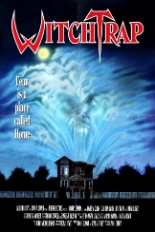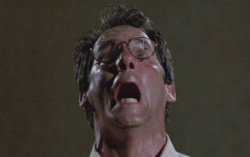
 Despite sharing a writer/director, several cast members and even the frickin’ typeface for the posters, Kevin S. Tenney’s Witchtrap is not a sequel to Kevin S. Tenney’s Witchboard, as the publicity took great pains to remind prospective viewers. Whatever its parentage, the name matters not/squat; Witchtrap is a fiendishly entertaining example of 1980s horror: not “good” enough for a theatrical run, but perfect for a weekend’s VHS rental (or Blu-ray purchase, as the case may be today).
Despite sharing a writer/director, several cast members and even the frickin’ typeface for the posters, Kevin S. Tenney’s Witchtrap is not a sequel to Kevin S. Tenney’s Witchboard, as the publicity took great pains to remind prospective viewers. Whatever its parentage, the name matters not/squat; Witchtrap is a fiendishly entertaining example of 1980s horror: not “good” enough for a theatrical run, but perfect for a weekend’s VHS rental (or Blu-ray purchase, as the case may be today).
Parapsychologist Dr. Agnes Goldberg (Witchboard alum Judy Tatum) scores a choice opportunity to test her ghost-vacuum theory (seriously) when she is hired by Devin Lauder (Tenney) to investigate strange goings-on at the mansion he’s inherited. The 19th-century Gothic abode is haunted by his multitasking Uncle Avery (Witchboard alum J.P. Luebsen), a psychic magician illusionist warlock. Devin would love to make bank renting the place out, but Avery’s ghost — and his accompanying “horrible, ungodly shrieks and moans” — scares people away and occasionally sends them to their death.
 Dr. Agnes recruits several teammates to assist, including physical medium Whitney (Kathleen Bailey, 1989’s Night Visitor) and acid-washed video technician Ginger (Linnea Quigley, Tenney’s Night of the Demons). As mandated by Devin, three security operatives tag along to provide protection — most notably the loudmouthed Vincente (Witchboard alum James W. Quinn, having an absolute ball, which sets the proper vibe for viewers). Vincente gets all the great lines, from “You. You are a real Neanderfuck, do you know that?” to “I always knew you were a scumbag, but I never knew how scummy a bag you could be!”
Dr. Agnes recruits several teammates to assist, including physical medium Whitney (Kathleen Bailey, 1989’s Night Visitor) and acid-washed video technician Ginger (Linnea Quigley, Tenney’s Night of the Demons). As mandated by Devin, three security operatives tag along to provide protection — most notably the loudmouthed Vincente (Witchboard alum James W. Quinn, having an absolute ball, which sets the proper vibe for viewers). Vincente gets all the great lines, from “You. You are a real Neanderfuck, do you know that?” to “I always knew you were a scumbag, but I never knew how scummy a bag you could be!”
Security was a good call, what with the inverted cross and pentagram-emblazoned altar still assembled in the attic. However, they don’t exactly excel on the job, as team members expire in quick succession, each in a method wholly unique from the one before, but all accompanied by Whitney flailing about in a whip-my-hair combo of grand mal seizure and mind-blowing orgasm as her body channels Uncle Avery’s malevolent spirit; Bailey does an admirable best to sell this peculiar blend of gyrations, but Tenney needle-drops a theme of maddening bombast as if in doubt.
Whether his characters are done in by bullet, vehicle or showered, Tenney clearly relished staging every demise — the very reason films like Witchtrap exist, of course. (Also, now is as apt a time as any to say that Ghostvacuum would make a more fitting title.) The practical effects are standouts even at a cut-rate level, in particular a final scene that recalls Vincent Price’s candle impersonation at the end of Tales of Terror. As with Tenney’s other horror highs, Witchtrap plays like a plastic pumpkin overflowing with Halloween candy, with nary an apple or any other good-for-you alternative in sight. You’d have to be a Neanderfuck to think otherwise. —Rod Lott
